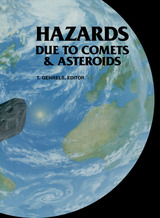2 books about Astrogeology

Hazards Due to Comets and Asteroids
Edited by T. Gehrels
University of Arizona Press, 1995
In 1993, the U.S. Department of Defense declassified information dealing with frequent explosions in the upper atmosphere caused by meteoric impact. It is estimated that impacts have occurred of a magnitude equivalent to the atomic bomb detonated at Hiroshima. Not all such space voyagers meet their end in the atmosphere, however; huge craters attest to the bombardment of earth over millions of years, and a major impact may have resulted in the extinction of dinosaurs. An impact in Siberia near the beginning of this century proves that such events are not confined to geologic time. Hazards Due to Comets and Asteroids marks a significant step in the attempt to come to grips with the threats posed by such phenomena. It brings together more than one hundred scientists from around the world, who draw on observational and theoretical research to focus on the technical problems related to all aspects of dealing with these hazards: searching for and identifying hazardous comets and asteroids; describing their statistics and characteristics; intercepting and altering the orbits of dangerous objects; and applying existent technologies—rocket boosters, rendezvous and soft-landing techniques, instrumentation—to such missions. The book considers defensive options for diverting or disrupting an approaching body, including solar sails, kinetic-energy impacts, nuclear explosives, robotic mass drivers, and various propulsion systems. A cataclysmic impact posing a threat to life on Earth is a possibility that tomorrow's technology is capable of averting. This book examines in depth the reality of the threat and proposes practical measures that can be initiated now should we ever need to deal with it.
[more]

Resources of Near-Earth Space
John S. Lewis
University of Arizona Press, 1993
Originally published in 1993
From the original publication:
A base on the Moon, an expedition to Mars. . . . Some time in the near future, for scientific or cultural reasons, humanity will likely decide to pursue one of these fantastic ventures in space. How can we increase the scope and reduce the cost of these ambitious activities?
The parts of the solar system that are most accessible from Earth—the Moon, the near-Earth asteroids, Mars and its moons—are rich in materials of great potential value to humanity. Resources of Near-Earth Space explores the possibilities both of utilizing these materials to produce propellants, structural metals, refractories, life-support fluids, and other materials on site to reduce the costs of space exploration, and of providing a source of materials and energy for our own planet that would not be environmentally destructive to Earth.This volume summarizes the present state of the art in attempts to realize these possibilities: identifying the resources, mining and processing, transportation, and economics. As a broad survey of a rapidly evolving field, it is intended as a technical introduction to the use of nonterrestrial materials for scientists, engineers, and industrial and governmental project managers who seek to make space more accessible.
The parts of the solar system that are most accessible from Earth—the Moon, the near-Earth asteroids, Mars and its moons—are rich in materials of great potential value to humanity. Resources of Near-Earth Space explores the possibilities both of utilizing these materials to produce propellants, structural metals, refractories, life-support fluids, and other materials on site to reduce the costs of space exploration, and of providing a source of materials and energy for our own planet that would not be environmentally destructive to Earth.This volume summarizes the present state of the art in attempts to realize these possibilities: identifying the resources, mining and processing, transportation, and economics. As a broad survey of a rapidly evolving field, it is intended as a technical introduction to the use of nonterrestrial materials for scientists, engineers, and industrial and governmental project managers who seek to make space more accessible.
[more]
READERS
Browse our collection.
PUBLISHERS
See BiblioVault's publisher services.
STUDENT SERVICES
Files for college accessibility offices.
UChicago Accessibility Resources
home | accessibility | search | about | contact us
BiblioVault ® 2001 - 2024
The University of Chicago Press








